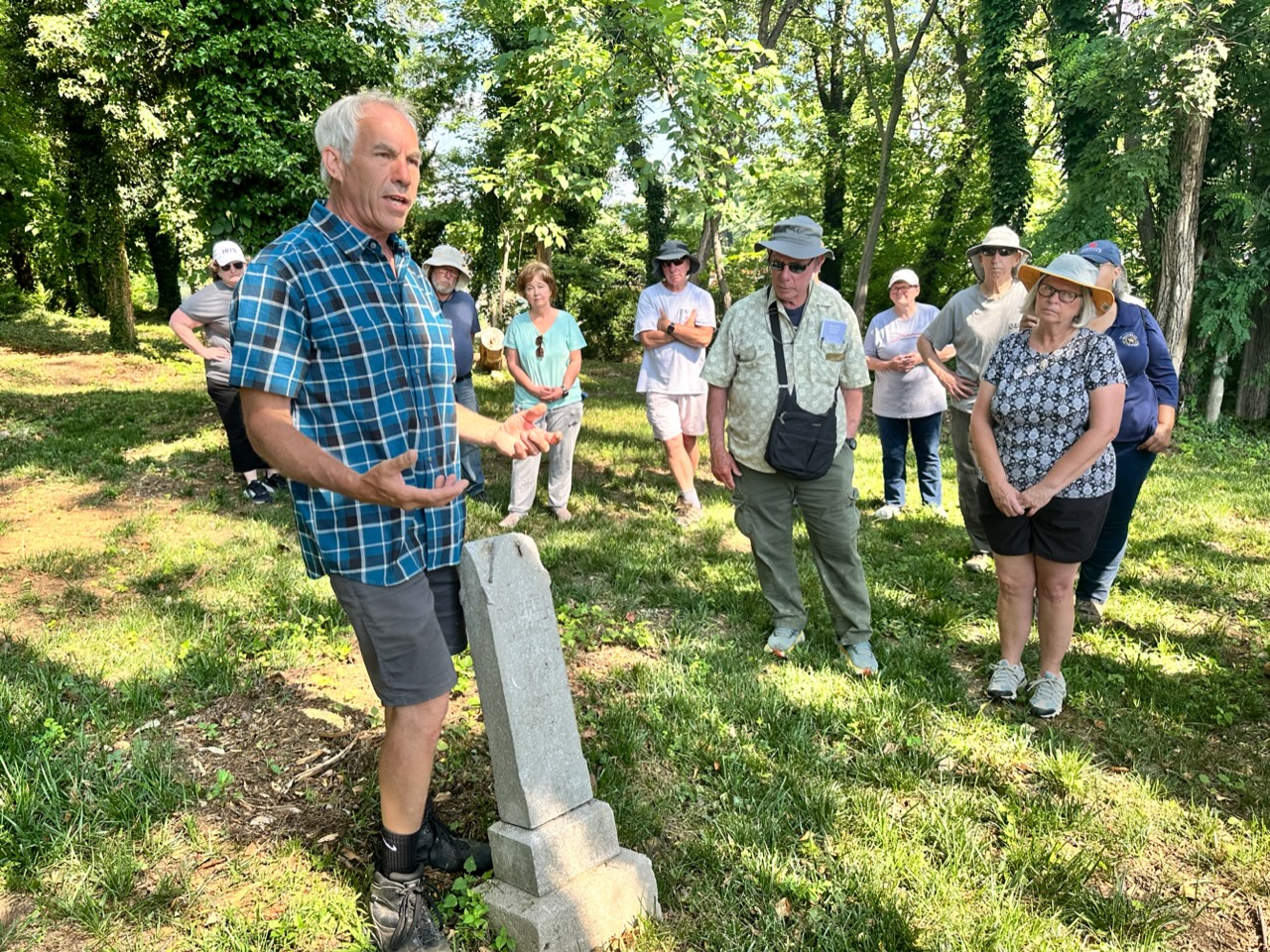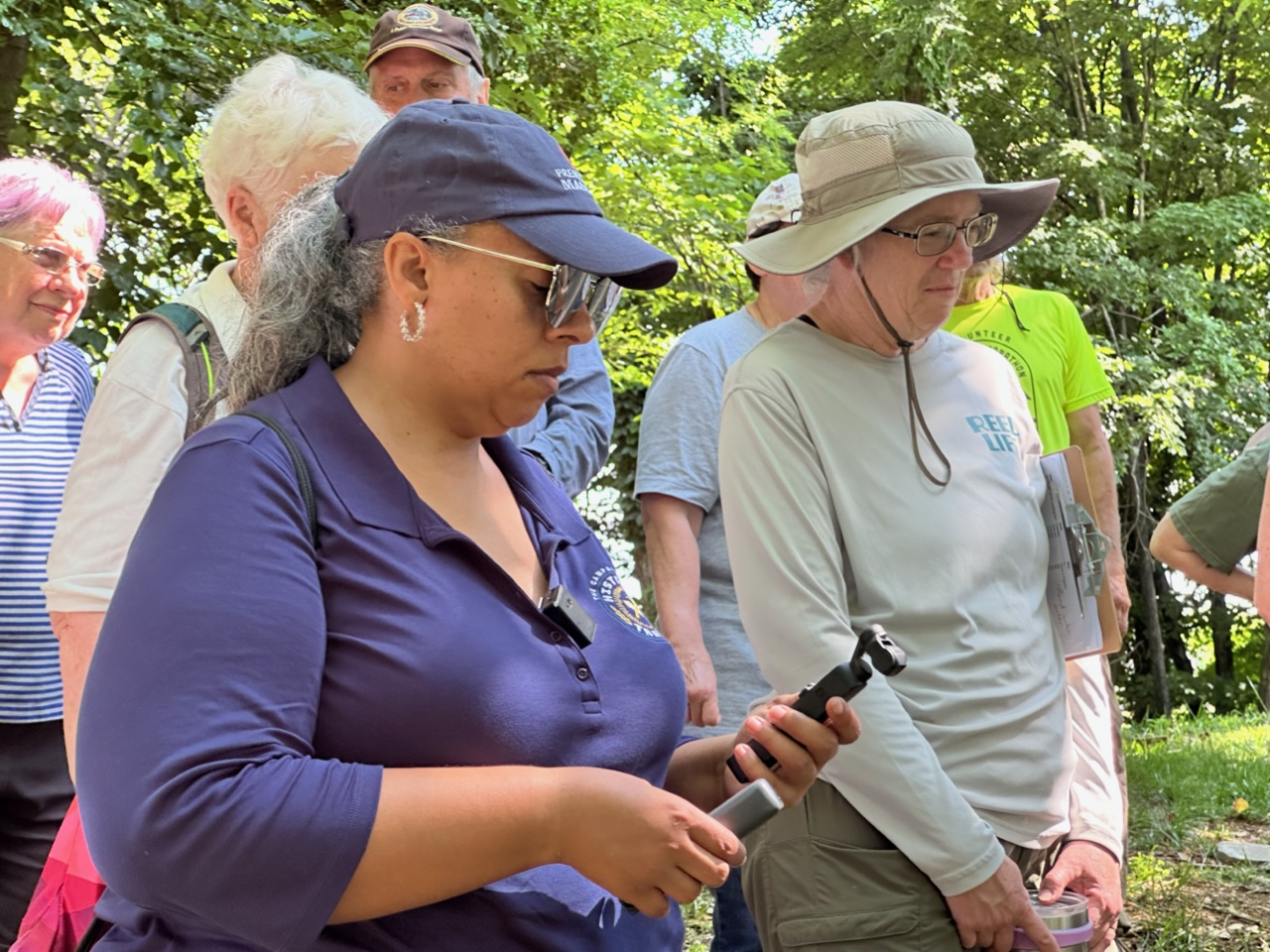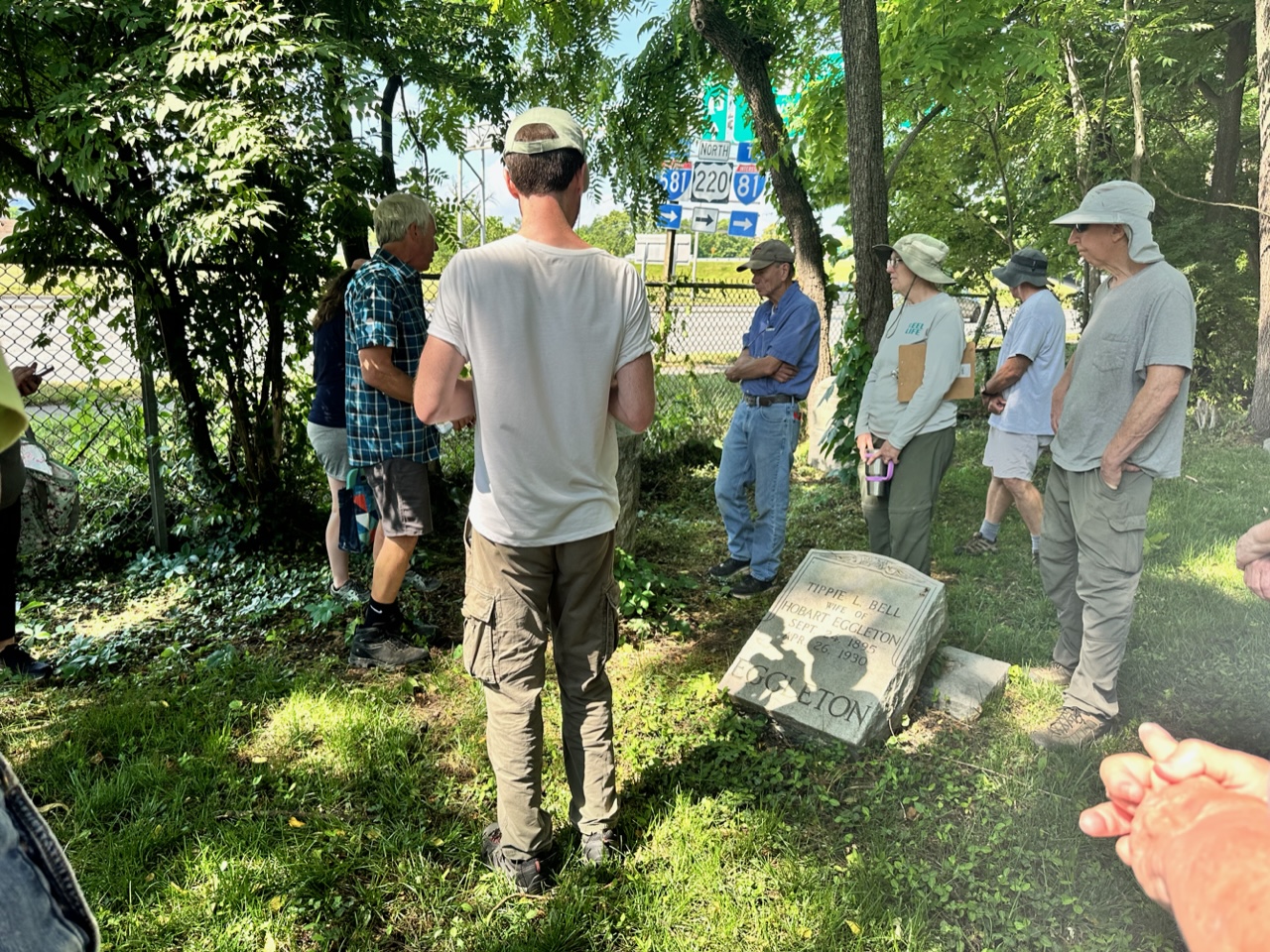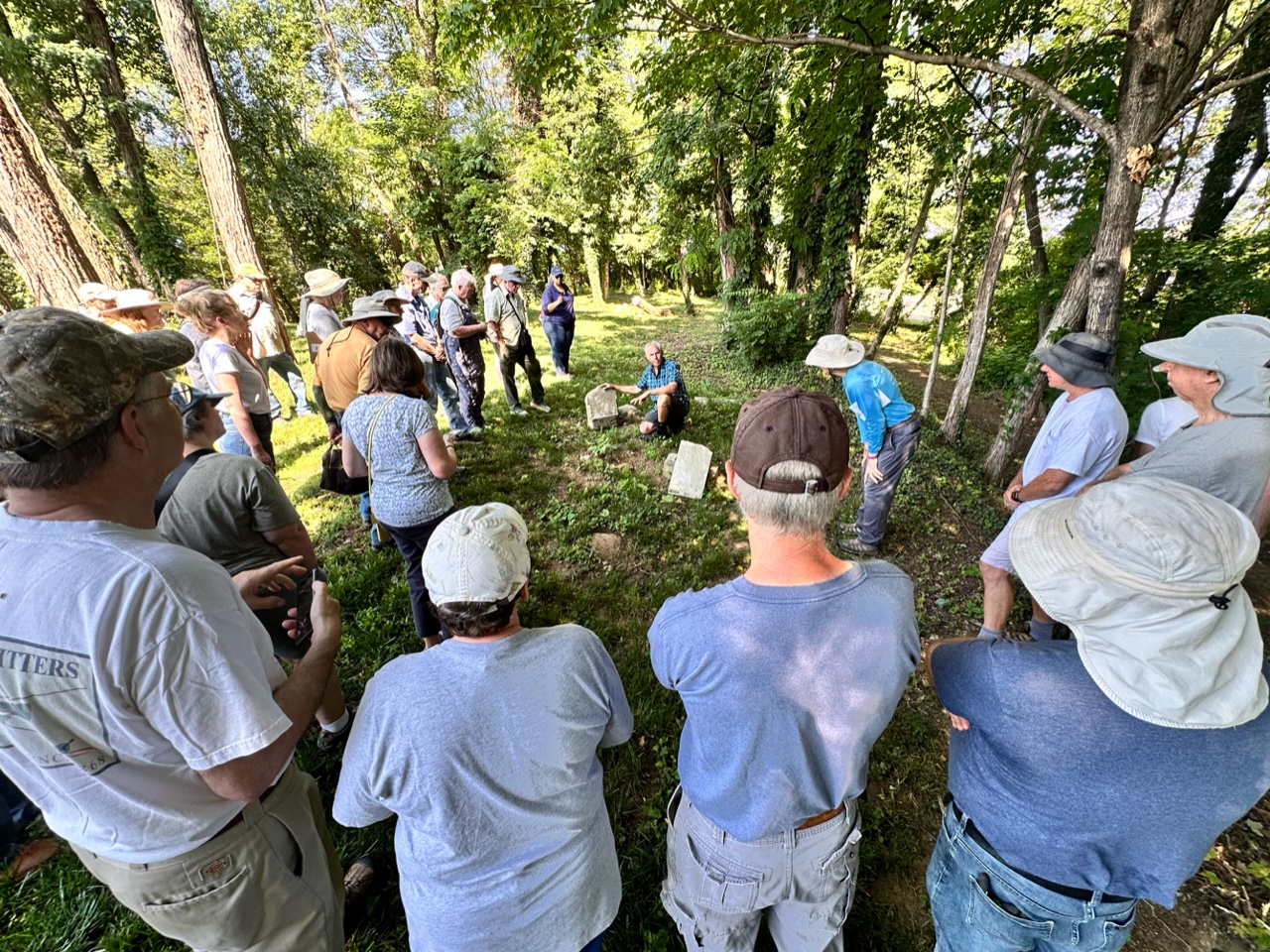Until Tuesday, the tombstone of the Rev. J.J. Jefferson lay face down in the dirt of Roanoke’s Old Lick Cemetery, a historic African American graveyard decimated more than 60 years ago in the name of urban renewal.

But now the marker stands erect once more, facing in the direction of Mt. Zion AME Church, which Jefferson founded in 1884.
The church is long gone now — another casualty in the war for “progress” — but thanks to an all-volunteer nonprofit, the homes of some African American dead may fare better than those of the living.
“The goal of our organization is to bring respect and dignity back to this cemetery and make it a place where people can come on the summit and sit and meditate and consider what has happened and where we are going,” said Ellen Forbes Stick, president of Friends of Old Lick Cemetery.
The group organized the restoration workshop on Tuesday within sight and sound of the project that destroyed it in 1961: Interstate 581, which claimed at least 933 burial sites in the Black cemetery.
The free hands-on workshop was funded and led by Jonathan Appell, a national expert on monument restoration and president of 48 State Tour/Saving America’s Graveyards. Since 2020 Appell has led 143 such events across the U.S.
“This tour is the most ambitious to date,” Appell said. “The broader goal is to teach people the skills they need, because every town and city around the whole country needs this and there’s almost never any money and very few people who are knowledgeable, and so that’s what empowered me to start this whole thing.”

Appell’s team, consisting of his partner and a documentarian, plans to travel 15,000 miles across the U.S. hosting 56 events in 48 states. Roanoke was stop number two in week two; on Wednesday he’s scheduled to be at Lynchburg’s Old City Museums and Arboretum.
More than 30 volunteers, all of them white, showed up Tuesday at the cemetery that’s separated from busy Orange Avenue by a rusty chain-link fence. Most were Roanokers whose churches like the Basilica of St. Andrew Catholic Church have their own historic cemeteries. But others came from Bedford, Lexington, Hopewell — even a woman from Pfafftown, North Carolina, who made the detour en route to a bridal shower in Connecticut.
“There are multiple ways to get from North Carolina to Connecticut,” said Suzanne Dorsett, a cemetery preservationist who follows Appell’s mission. “This one really tugged at my heart because it was an African American cemetery, because it’s a social justice issue. I was expecting to see more Black or brown faces today. It’s cool the older white folks who are retired are out here doing this, but I was expecting a more mixed group, honestly.”
* * * 
Not surprised was Hopewell resident Kelly Pratt with Preservation Maryland’s Campaign for Historic Trades and the lone African American in attendance.

“It really depends on the community that surrounds [the cemetery] and how well word travels,” said Pratt, who was at the Old Lick event to learn more about monument preservation. “But this is very common. I didn’t even know this was a Black cemetery until I pulled up and was like, oh, there’s a highway, this is probably a Black cemetery and they just mowed right through it.”
Thousands of Black people were buried in Old Lick Cemetery starting in the 1890s until its final burial in 1952.
About 900 remain today. In addition to Jefferson are veterans of World War I and even one who fought in the Civil War.
According to Friends literature, John Winston Leftridge was born — likely into slavery — in Bedford County in 1837, but as a young man escaped to Ohio.
In 1862 he enlisted in the U.S. Army and was assigned to Company F of the 100th Regiment, U.S. Colored Infantry. He guarded rail lines in northern Tennessee and Kentucky and fought in the battle of Nashville.
After the war he returned to Ohio to work as a laborer but eventually needed treatment at the National Home for Disabled Volunteer Soldiers. In 1903 he returned to Virginia and died Aug. 20, 1918.
* * * 
Old Lick’s demise began nine years after its final burial when a portion of the land was claimed by eminent domain for construction of I-581. At least 933, but perhaps as many as 1,300, graves were impacted. Families were notified about the removal only by a few announcements in The Roanoke Times and were given one month to find new burial sites for their relatives.
It was one of many projects, including the Berglund Center and other commercial development, that affected not only Roanoke’s living African American residents, but its dead as well.
“The city has not treated well our African American community, and this is part of that,” said volunteer Richard Fife of Roanoke’s St. John Episcopal Church. “Half of the cemetery was taken and a lot of people were exhumed and taken far away. This work is to honor them and do justice and do right by them.”
Over the decades, much of the site fell into disrepair. The parcel containing the remains of First Baptist Church of Gainsboro congregants was maintained by the church, but the rest was overgrown by weeds and paradise trees.
As social studies supervisor for Roanoke City Public Schools, Ellen Forbes Stick wanted to give city teachers and students an opportunity to learn more about Roanoke’s history. In March 2019, she began work on the cemetery and kept it as a pet project after her retirement in December 2020.
“I feel like the Old Lick Cemetery has been the gaping wound left over by the 1960s,” she said.
After her retirement, Stick founded the Friends group, which has cleared much of the property that First Baptist has agreed to keep mowed, despite its congregation’s declining size and members’ declining health. She credits the church’s Bob Hale, who died in 2020, as one of her inspirations in maintaining the cemetery.
Friends also recruited a volunteer to use ground penetrating radar to discover and identify graves. In addition to Tuesday’s workshop with 48 State Tour/Saving America’s Graveyards, Friends hopes to replace the old fence with something more stately, like black wrought iron, that’s more befitting the sacred space.
Friends meets the second Saturday of each month to work on the property, and on Tuesday may have recruited a new volunteer whose business is cemeteries.
Mart Clamp owns a mobile monument repair service from the Granite Capital of the World — Elberton, Georgia. He helps maintain several Roanoke cemeteries as part of his work, and he showed up with his truck Tuesday to help restore some of the tombstones.
From his experience visiting cemeteries around the country, he doesn’t see race as much of a factor in Old Lick’s history: “Let me tell you, with eminent domain as cover, it makes no difference what color you are, if you’re in the way of progress they will move you.”
Surveying the site and the dozens of volunteers, Clamp said, “I’m a contractor, I only do this sort of work if people pay me to do it. But a lot of these people here, they’re taking their time from their jobs to come clean up and recognize people they don’t even know. That’s pretty impressive.”
He said he planned to join Friends of Old Lick Cemetery by the end of the day. 



